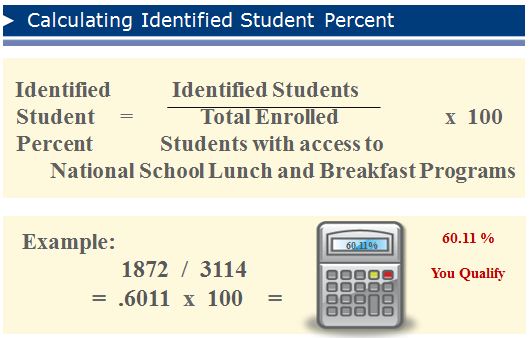Community Eligibility Provision
The Healthy, Hunger-Free Kids Act of 2010 (Public Law 111-296) offers local education agencies (LEA) an alternative to collecting household applications in the National School Breakfast and National School Lunch Programs, which eliminates the unnecessary paperwork and frustration that can go along with the process.
Community Eligibility Provision is a reimbursement option for eligible LEAs and schools that wish to offer free meals to all children in high poverty schools.
Important Update:
The deadline for LEAs to opt into the Community Eligibility Provisions (CEP) for the following school year is June 30, using data reflective of April 1. Please contact ra-nslp@pa.gov for more information.
Online Resources
LEA Considerations
- Determine what schools within the LEA could participate.
- Send clear/effective communication to all students/households about the nutritional benefits of eating school meals.
- Determine the anticipated Federal Reimbursement for schools participating.
- Plan for potential issues that may arise due to the absence of data, which may normally be used for other educational purposes.
- Determine what other non-federal funds could be used to supplement Federal Reimbursement.
Definitions
Enrolled Students: Students enrolled in and attending the schools participating in the Community Eligibility Provision who have access to at least one meal service daily.
Identified Student: Disadvantaged and/or students at or below the national poverty level who are also identified as: SNAP, homeless, runaways, categorically eligible youth, foster, etc.
Identified Student Percentages: Determined by the number of identified students, divided by the total number of enrolled students with access to National School Breakfast and National School Lunch Programs, multiplied by 100.
Claiming Percentages
 The identified student percentage is multiplied by a factor of 1.6 to get the claiming percentage and the Free Federal Reimbursement Rate.
The identified student percentage is multiplied by a factor of 1.6 to get the claiming percentage and the Free Federal Reimbursement Rate.
The 1.6 factor is based on an analysis that showed on average for every 10 identified students, there were six more students certified based on an income application. Therefore, if you multiple the identified student percentage by 1.6, you are approximating the free and reduced Federal Reimbursement Rate percentage.
The remaining percent of total meals is then reimbursed at the Paid Federal Reimbursement Rate.
Meal costs in excess of the total Free and Paid Federal Reimbursement Rate must be covered by non-federal sources.
Example:

Benefits
- LEAs do not have to collect student and household applications.
- Meeting the 40 percent threshold allows all students to eat for free.
- Increased breakfast and lunch participation among students.
- Improved nutrition to disadvantaged and high-poverty students.
- Simplifies meal counting and claiming, student is claimed as either free or paid (no reduced pricing).
- Eliminates overt identification issues for students.